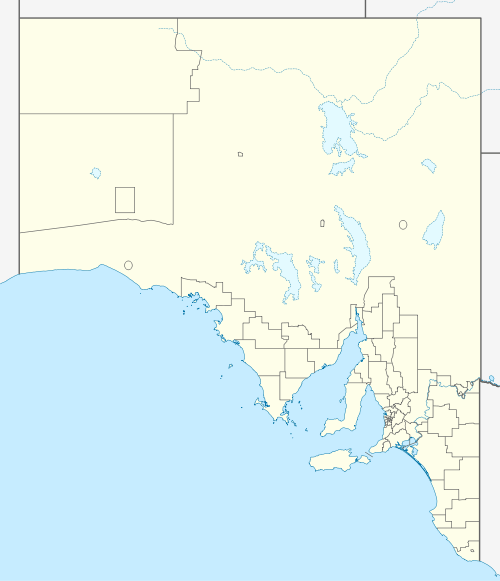Anlaby Station
Anlaby or Anlaby Station is a pastoral lease located about 12 kilometres (7 mi) south east of Marrabel and 14 kilometres (9 mi) north of Kapunda in the state of South Australia.

History
The locality was first explored by Europeans in March 1838 by the party of Hill, Wood, Willis, and Oakden, who were scouting an overlanding route from the Murray.
The station is the oldest merino stud in Australia and was settled in 1839 by Capt. John Finnis,[1] who called it "Mount Dispersion"[2] (the Aboriginal name was Pudna), and stocked it with 12,000 sheep.[3] The property was acquired in 1841 by Frederick Dutton, at which time it was at the frontier of European settlement. In the early days Anlaby extended from near Kapunda to Tothill's Creek occupying an area of 160,000 acres (64,750 ha) with a length of 25 miles (40 km) and a width of 10 miles (16 km).[4] The neighbouring pastoralist to the west and north was W. S. Peter, while to the south was Bagot's Koonunga. To the east was the Murray scrub. A two-man mounted police station was established at Julia Creek between 1842 and 1846 to protect the Anlaby and Koonunga flocks from attacks by local Aboriginal people. The property ran as many as 70,000 sheep and shearing lasted nine months, employing 70 people.[5]
In 1843 a log hut was constructed for the manager Alexander Buchanan. The name of the run was also changed by Dutton to Anlaby, the name of the Yorkshire village that his sister's husband hailed from.[4] By 1851 the property had been reduced to 70,000 acres (28,328 ha), with the loss of another 24,000 acres (9,712 ha) so that closer settlement could be made. Another 30,000 acres (12,141 ha) from Anlaby was subdivided for wheat farming up until 1917. Returned servicemen were allocated another 8,000 acres (3,237 ha) between 1918 and 1922 in the Soldiers Settlement Scheme. The manager, whose son, also named Alexander Buchanan, became Master of the South Australian Supreme Court, died in 1865,[6] and his place was filled by Henry Thomas Morris (1823–1911), a nephew of John Hindmarsh, and one of the original HMS Buffalo immigrants of 1836.[7] Later managers were Peter and Mayoh Miller, then C. Campbell.[8]
Frederick Dutton died in 1890 and left Anlaby to his nephew Henry Dutton, who carried out extensive improvements and married the accomplished musician and socialite Emily Martin on 29 November 1905. On Henry's death in 1932 she took over management of the station and cattle stud.[9]
The Anlaby Pastoral Company was formed in 1960 and took over control of the property. Partners were Emily Dutton (manager), John H. Dutton, Geoffrey P. Dutton, Helen Blackburn and Leonie Dutton. By 1968 the stud and property were acquired by the Mosey family. In early 2009 Andrew Morphett acquired Anlaby.[9]
Anlaby Homestead and the Anlaby Shearing Shed, Slaughterhouse, Shearers' Quarters and Manager's House are both separately listed on the South Australian Heritage Register.[10][11]
The prolific author Geoffrey Dutton grew up at Anlaby, and includes information about his ancestors in his 1985 book The Squatters.[12]
See also
References
- "Dutton, Francis Stacker (1818–1877)". Australian Dictionary of Biography. Australian National University. 1966. Retrieved 26 August 2013.
- Not to be confused with Mount Dispersion, New South Wales.
- "Early South Australians". The Advertiser. Adelaide. 1 January 1929. p. 12. Retrieved 20 December 2015 – via National Library of Australia.
- "Dutton Family Records" (PDF). Government of South Australia. 8 March 2013. Archived from the original (PDF) on 7 April 2014. Retrieved 26 August 2013.
- "Anlaby Homestead". Nine Network. 23 May 2010. Archived from the original on 19 March 2014. Retrieved 26 August 2013.
- Alex Buchanan's daughters Penelope (c. 1862 – 2 March 1935) and Alice ( – 21 December 1941) married sons of Edward Wharton White (c. 1864 – 10 January 1949), a brother of James White, pastoralist and politician.
- "Death of a South Australian Pioneer". The Border Watch. Mount Gambier, SA. 25 October 1911. p. 4. Retrieved 21 December 2015 – via National Library of Australia.
- "Anlaby, an Historic Estate". The Register News-Pictorial. Adelaide. 10 September 1929. p. 5. Retrieved 21 December 2015 – via National Library of Australia.
- "Stud Details Stud name: Anlaby". Australian Association of Stud Merino Breeders Limited. 2012. Archived from the original on 2 November 2013. Retrieved 26 August 2013.
- "Anlaby Homestead (including main & bluestone dwellings, stables, grotto, courtyard & quarters)". South Australian Heritage Register. Department of Environment, Water and Natural Resources. Retrieved 4 May 2016.
- "Anlaby Shearing Shed, Slaughterhouse, Shearers' Quarters and Manager's House". South Australian Heritage Register. Department of Environment, Water and Natural Resources. Retrieved 4 May 2016.
- "Papers of Geoffrey Dutton". Retrieved 19 November 2014 – via National Library of Australia.